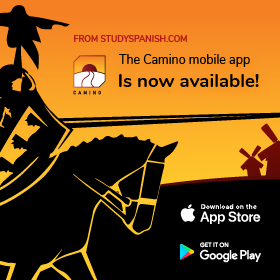Cultural Notes
-
Topics
- A Jungle Hike Through Shuar Country
- Asturias, the Natural Paradise of Spain
- Camels in South America (new)
- Caño Negro Wildlife Refuge
- Canopy Walking
- Celestún
- Cervantes
- El Chimborazo
- Christmas Eve and Christmas Day
- Christmas Time
- Climbing Cotopaxi
- Courtyards of Latin America
- Covadonga, un Santuario Histórico
- Crucifix Art in Latin America
- Cuzco
- Eating Street Food In Mexico
- Ecolodge Pioneers in Chiapas, Mexico
- El Greco
- The Sack Man
- La Sidra de Manzana; Deliciosa Tradición
- Floating Islands of Uros (ADVANCED LEVEL)
- Friends of Teacapán
- Las tortugas de caparazón gigante
- Guanajuato
- Guelaguetza
- Huichol Yarn Paintings
- Las cataratas de Iguazú
- Kings Day
- La Alhambra de Granada (ADVANCED LEVEL)
- La Tovara
- Laguna Quilotoa
- The Houses of the Indianos
- Lima
- Machu Picchu
- Madrid
- Mangroves of Pacific Mexico
- Mazatlan Aquarium
- Meet Minnie
- Mexican Cemetery Walk
- Monarch Butterfly Sanctuary Michoacán Mexico
- Morning in Teacapán
- El perro de monte
- Nopal
- Old Year
- Paella
- Papallacta Hot Springs
- La Piñata
- Quetzaltenango
- Ride the Bus in Mexico
- Running with the Tarahumara
- Salvador Dalí
- San Blas
- Sculptures In Leather
- Spanish Culture
- Spray Paint Art
- Las tiendas
- Studying Spanish in Latin America
- El tango
- Techos de México
- Teitos of Somiedo - Asturias
- Termites
- El Álamo
- Andean Condor (new)
- The Animal Carvings of Oaxaca - alebrijes
- The Bakeries of Mexico
- The Black Pottery of San Bartolo Coyotepec
- The Bronze Sculptures of Alejandro Colunga
- Cabrales Cheese Festival (new)
- The Cardón Cactus
- The Cenotes Of Yucatan
- Los conquistadores
- The Copper Work Of Santa Clara del Cobre
- The Island of Janitzio
- The Meat Markets of Mexico
- La Noche de San Juan
- The Night of the Radishes
- The Paramo
- The Plazas of Mexico
- The Ruins of Palenque
- El perezoso
- The Spirit of Angangueo
- The Textile Market of Otavalo
- The Vizcaino Desert
- The Water Boils - Hierve el agua
- La península de Yucatán
Caño Negro Wildlife Refuge
Two versions are available. The short version is one paragraph, the long version is four paragraphs. Both have photos and audio. The long version also has comprehension questions and links to other resources about the Caño Negro Wildlife Refuge.
Please select:
Method of Study
An effective way to study is to read and listen to the short version first. Depending upon your level, you may need to do this several times. Then, after you become familiar with the topic, read and listen to the longer version.
Don’t be Discouraged!
The audio has not been slowed down, so don’t be discouraged if you find these to be challenging – most students do. But, if you want to eventually be able to understand real conversations, you need to practice listening to material that is recorded at normal speed.
Motivated students listen to each version a number of times. First they follow along on the transcript, and later they just listen and try to pick out as many words and phrases as they can.
These are for All Levels
Beginners gain insight into Spanish culture by reading the English version of the essays and listening carefully to the short version. Intermediate level students expand their vocabulary. Even advanced students will find the audio of the long versions to be quite challenging.

